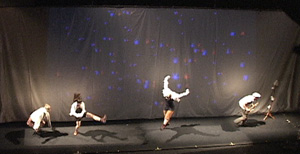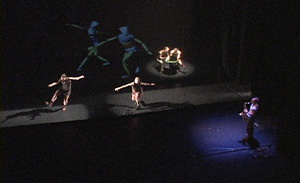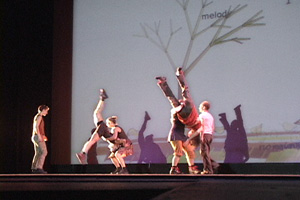The
2003 Production, Fibonacci + Phi
About the Dance
Production
Fibonacci + Phi Dance Production was a production
of Alban Elved Dance Company in collaboration with me
and other Wake Forest faculty, students and staff members.
The production was performed in MainStage,
Wake
Forest University, on December 4-7, 2003. The theme of
the dance was about a one-day experience of a woman,
called Amanda. It incorporated computer technology, poems,
and
scientific concepts of Fibonacci and Phi in the dance
performance. There are total 13 numbers in the performance.
The three
numbers that incorporated my work are described
in the Activities Pursued section below.
Reviews
There were two publications in Winston-Salem Journal
about the Fibonacci and Phi dance production—one
published in Relish was an interview before the show
and one was a review after the first day of the show.
Photocopies
of these two articles are enclosed at the end of this
report. Here are excerpts from a review by Susan Gilmor,
Journal
Arts Reporter of Winston-Salem Journal, December 5, 2003.
"She (Ms. Lüttringhaus) and her collaborators
have much to be proud of. 'Fibonacci & Phi' not
only provides an intriguing and challenging evening
of dance,
but also leaves the audience with plenty of ideas and
images to reflect on in the weeks to come..."
" It is a remarkably innovative piece, both profound and
visually dazzling... The beauty of the dance is only
part of what's going on here."
"In
one of the most striking sequences, dancers perform
in a virtual 3-D snowfall, brought to life through
the
3-D glasses that are passed out before the show."
"The
music ... evokes the mood and meaning of the piece...
Math never sounded so good... It would be easy
for lesser performers to get lost in the dazzle of
the onstage technology. But with the grace, strength
and athleticism
of these dancers...that's not an issue."
Activities
Pursued
Number 7: Amanda's Dream, Snow with 3D Glasses
I created a 3-D stereoscopic snowfall animation,
using Alias Maya and Adobe Premiere. Incorporated in
the 3-D animation were snowflake photomicrographs taken
about
100 years ago. Her intent was to "resurrect" these
snowflakes that once lay motionless under a microscope
by realizing an animation of their imaginary journey.
The audience could imagine and appreciate the transient
existence
of these "masterpieces of design" as they watched
the animated snowflakes falling on the dancers. The snowfall
animation was produced as an anaglyphic (red/blue) 3-D
animation to create the illusion of virtual snowflakes
-- which signify the past -- interweaving with the dancers
-- the present.

Figure 1. A frame from a video clip
of the Fibonacci
+ Phi Dance Production Number 7: Amanda's Dream,
Snow with 3D Glasses, showing four dancers dancing in an
anaglyphic (red/blue) 3-D snowfall scene.
Number
8: Amanda's Nightmare, Manipulation Dance
Artists use mannequins posed in various ways to render
accurate copies of human gestures and motion. The paradoxes
that I wanted to express in this piece were:
What if the roles were reversed? What if a human tried
to dance with a mannequin, and the mannequin led the dance?
Who, then, is the master of whom? In Manipulation Dance,
two computer 3-D models of mannequins, created in 3ds max
and computer programmed in Macromedia Director,
led a dance with human partners.
Although
the mannequins’ movements
were based on motion capture data, their movements became
original and unexpected during the performance by means
of an original twist in this design. Taking a signal
from dancers by means of a wireless joystick and a computer
keyboard, the upper and lower bodies of each mannequin
were able to move independently. Each of the upper and
lower bodies could dance forward or backward in its own
timeline and at its own speed.
To
enable an interaction between human and computer, live
dancers on stage tried
to keep up with the mannequins. The Manipulation Dance
explored the nonlinear re-creation of dance phrases
by deconstructing and recombining pre-choreographed movements
in real-time into new forms of expression.
INTERACTIVE
DEMO: Click here to manipulate
the mannequins yourself.

Figure 2. The image is a frame from
a video clip of the Fibonacci + Phi Dance Production Amanda's
Nightmare, Manipulation Dance. It shows two
dancers mimicking the movement of two
mannequins projected on a scrim. Two other dancers sitting
at a table were controlling the movement of the mannequins
with a computer keyboard and a joystick.
Number
9: Picnic in the Park under the Fractal Tree
This tree, created in Macromedia Flash,
was an interactive piece called Fractal Tree of Verses.
It expressed the reflection that if we pass up the chance
to appreciate beauty, all we will see is the gibberish
on the ground. In this piece, words become part of the
trees' foliage. Each fractal tree is computer-generated
in real-time—each tree generated is unique; the chance
you see the exact same tree again is extremely low.
Each
twig grows a word, a phrase, or a leaf. When the shedding
of the foliage was triggered, words started falling
and flying off the twigs. While the audience's eyes jumped
from word to word or followed their paths, the words might
recombine into sparks of verses in their mind. Each audience
member might construct a different poem by following different
words in a different order. Then, after this transient
moment of chaos, the words would fly off the screen or
drop on the ground and be jumbled together in an unintelligible
heap. The audience at the show provided some of the words
to grow on the fractal tree – some are audience's
hand-written words captured with a tablet PC.
The Fractal Tree of Verses was revised for the 2004 Wake
Forest Art Faculty and Staff Exhibition to allow the viewers
to contribute words to the fractal tree's foliage.
INTERACTIVE
DEMO: Click
here to see the revised version.

Figure 3. The image is a frame from
a video clip of the Fibonacci + Phi Dance Production
Number 10: Picnic in the Park under the Fractal Tree.
It shows the dancers dancing in
front of a graphical fractal tree with words.
|